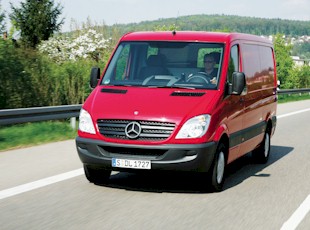Trucking On

With General Motors feeling the pinch, other major manufacturers such as Tata Motors and Mercedes-Benz continue to roll out new models and engines.
As predicted in last month’s Global FOCUS, India’s largest vehicle producer, Tata Motors, has taken the wraps off its new ‘World Truck series’, which is expected to be priced some 5 to 10% above the manufacturer’s current line-up. While only limited detailed technical specifications were provided, it has been established that the total medium-to-heavy duty range will include multi-axled units, truck-tractors, tippers, truck mixers and special application vehicles, in 4×2, 6×2, 8×2, 6×4, 8×4 and 10×4 configurations, ranging in size from 10 t gross vehicle mass (GVM) to 75 t gross combination mass. Power is to be provided by a range of engines sourced from the Tata Cummins Indian joint venture (JV) (ratings up to 285 hp/212 kW) and Cummins India Limited (over 300 hp/225 kW), covering the full power spectrum from 150 to 560 hp (120 to 420 kW), plus some additional options from the Iveco Cursor engine family. Transmissions are sourced from Eaton and ZF, with ZF providing both Ecosplit manual and AS Tronic automated mechanical units, the latter being an optional fitment.
Emissions compliance covering the spectrum from Euro III to Euro V has been built into the World Truck design, and other available features will include air suspensions and GPS-based navigation systems, while the range calls up components sourced from a number of global vendors based in Italy, Germany, Sweden, the United States, Japan and South Korea. Design of the air-conditioned cab, which has been specified to meet the demanding Swedish crash test regime, was reportedly entrusted to Stile Bertone of Italy. It is to be offered in three lengths: day, rest and full sleeper, with three different roofheight configurations and two interior trim levels. Fully adjustable reclining suspension seats are being supplied by a joint venture between Tata Johnson Controls Automotive and Isringhausen, and the cab specification also includes adjustable steering columns and integrated seat belts.
Development of this range has consolidated inputs from Tata Motors in India, Tata Daewoo Commercial Vehicle Company in South Korea and Tata Motors’ European Technical Centre in the United Kingdom, and test units are currently running at Tata’s Jamshedpur facility, ahead of initial launch in September. Production will take place in India and South Korea, and is reportedly planned to ramp up to 20 000 units per annum over a four-year period, with the possibility of production in Thailand and Burma also under consideration. In addition to the domestic Indian and Korean markets, these models are to be progressively rolled out to other South Asian countries, South Africa and the Middle East. It is notable that Tata has stated its intention to continue the production of its current truck series, as a more affordable alternative to the new range, while the present global economic crisis persists.
The market positioning of the World Truck series upward from 10 t GVM, plus the involvement of Tata Daewoo in its development and production processes, suggests that it will be the ultimate replacement for the current Novus line-up. The Novus was originally inherited by Tata when it acquired the heavy truck assets of the defunct Daewoo Group in 2004, by which time some of these models had been in existence in South Korea for nearly a decade. The original 1995 line-up included a comprehensive range of heavyduty 4×2, 6×4 and 8×4 trucks, with a cab designed and developed by UK company, Hawtal Whiting. The technical specifications included 6-, 8- and 10-cylinder MAN-derived diesel engines with outputs ranging from 225 to 380 hp (167 kW to 283 kW), and various driveline aggregates emanating from Korean Spicer, ZF and Tongil. Tata subsequently extended Novus production to India, using several Cummins-powered derivatives of the range to supplement the domestic product line-up. Under Tata’s stewardship, the Novus product identity remained largely intact, with some modernisation of the cab’s frontal styling, and the introduction of an extended Euro 3- compliant engine line-up equipped with Bosch common-rail fuel injection systems.
Early in 2006, the Novus range was extended downwards to include lighter 4.5 to 7 t payload 4×2 models. Interestingly, these units were equipped with 6-cylinder, 5.9-l Iveco NEF common rail diesel engines supplied in terms of a partnership agreement between Tata Daewoo and Iveco Motors/Fiat Powertrain Technologies of Turin. While the initial technical details provided for the new World Truck range relate only to heavier models, the emergence of a first-time Iveco engine option for units in this size category is noteworthy, and suggests that the lighter models are also likely to feature power from this source. The Fiat Group’s corporate relationship with Tata has recently lost some visibility while the Italian company pursued strategic options with Chrysler and other potential global partners, but the emergence of a Fiat/Iveco involvement in the Indian manufacturer’s World Truck project suggests that this connection is still firmly in place.
GM DUMPS ITS MEDIUM TRUCKS
Readers following the unfolding events surrounding General Motors’ recent entry into Chapter 11 Bankruptcy Protection in the US will be aware of the corporation’s efforts to sell off or close several group brands, including Hummer, Pontiac, Saturn and Saab. Global FOCUS has also been following developments relating to GM’s medium truck business, and has reported previously on separate negotiations that have taken place with Navistar International and Isuzu Motors concerning the possible sale of this business. In August 2008, the talks between GM and Navistar were terminated, presumably because of the collapsing US market, but earlier this year Isuzu emerged as a likely buyer, primarily because it had been selling around 30 000 Isuzu-, Chevroletand GMC-branded N-Series and F-Series trucks per annum in North America, while also supplying its diesel engines for optional fitment in the Chevrolet Kodiak and GMC TopKick semi-forward-control medium trucks built at GM’s plant in Flint, Michigan, in the United States. Indications were that the Isuzu prospect was more palatable to the GM workforce, presumably because Navistar had been expected to use its own plants to build products for any GM cooperation, whereas Isuzu would have the option of taking up capacity at Flint, where 22 000 trucks were built in 2008, rather than setting up its own new US build operation.
The latest reports suggest that no viable deal materialised from the Isuzu interaction, because, on 8 June 2009, GM announced the closure – by the end of July – of its medium-duty truck operations. This decision will immediately affect 398 Flint employees, as well as the 470 North American dealers currently holding the medium-duty franchise, who will be expected to sell off the remaining inventory over the next 18 months. It also, presumably, means the end of the line for the Chevrolet Kodiak and GMC TopKick trucks, leaving space to be filled in the market by competitive conventional-cab products from Navistar International, Blue Diamond (the Ford/Navistar JV), Freightliner, Kenworth and a resurgent Chrysler. It may also open up opportunities for market entries by additional foreign-owned manufacturers.
This decision marks the final end to GM’s own-account involvement in any commercial vehicle activities larger than the pickups and light vans of the LCV class. This process started in 1986, when the GM Heavy Truck Corporation was sold to Volvo, Bedford in the United Kingdom was scaled down into a van operation, and the process of selling off Detroit Diesel, first to Roger Penske, and finally to DaimlerChrysler, was started in 1988. In 2006, GM sold off its final shareholding in Isuzu Motors, ending an equity-holding relationship dating back to 1971. Although several, mainly light vehicle-focused cooperative interests lived on in a JV named GMI Diesel Engineering Limited, there was a clear indication that the American company had lost interest in the mainstream truck activities that were Isuzu’s principal area of activity, and the scene was set for a further winding down of GM’s trucking activities. This has also been reflected in Isuzu’s assumption of direct control over its Australian and South African truck operations.
However, the most important unanswered questions relate to the future of Isuzu’s North American truck business. The Japanese company has been active in the US with its own truck products for the past 25 years, selling 400 000 units during that period, and having become the dominant player in the US Class 3 to 5 market, where GVM ratings range from 4.5 to 7 t. More specifically, Isuzu products have led the American market for low-cab forward products since 1986. However, this success has been built on a substantial distribution network made up of 205 own-account Isuzu truck dealers, plus 350 GM dealers who sold the W-Series ‘badge-engineered’ Chevrolet and GMC versions of Isuzu’s N-series product. It has not been revealed how the changes in GM’s strategy will affect Isuzu’s future access to GM dealers, although the two manufacturers will continue their association through the DMAX engine joint venture located in Ohio in the United States.
NEW SPRINTER DIESELS
 Mercedes-Benz has launched a new family of diesel engines and manual transmissions for its best-selling Sprinter integral panel van range. The new engines have been introduced to ensure compliance with the latest Euro V emissions standards, which come into force for vehicles over 3.5 t GVM in October of this year, and to offer the option of the more stringent voluntary Enhanced Environmentally Friendly Vehicle rating. The all-new 2.15-l, 4-cylinder power unit is designated OM 651, and will be available in three variants rated at 95 hp (70 kw), 129 hp (95 kW) and 163 hp (120 kW), with torque outputs of 250 Nm, 305 Nm and 360 Nm respectively. Maximum rotational speed is set at 3 800 r/min for all versions, while the flat torque curve tops out between 1 400 and 2 500 r/min in the lowest output variant, between 1 200 and 2 400 r/min in the intermediate model, and between 1 400 and 2 400 r/min for the 120 kW powerplant. This engine differs significantly from its ‘square’ predecessor in having a considerably longer 99 mm piston stroke dimension.
Mercedes-Benz has launched a new family of diesel engines and manual transmissions for its best-selling Sprinter integral panel van range. The new engines have been introduced to ensure compliance with the latest Euro V emissions standards, which come into force for vehicles over 3.5 t GVM in October of this year, and to offer the option of the more stringent voluntary Enhanced Environmentally Friendly Vehicle rating. The all-new 2.15-l, 4-cylinder power unit is designated OM 651, and will be available in three variants rated at 95 hp (70 kw), 129 hp (95 kW) and 163 hp (120 kW), with torque outputs of 250 Nm, 305 Nm and 360 Nm respectively. Maximum rotational speed is set at 3 800 r/min for all versions, while the flat torque curve tops out between 1 400 and 2 500 r/min in the lowest output variant, between 1 200 and 2 400 r/min in the intermediate model, and between 1 400 and 2 400 r/min for the 120 kW powerplant. This engine differs significantly from its ‘square’ predecessor in having a considerably longer 99 mm piston stroke dimension.
Design features include twin gear-wheel and duplex chain-driven overhead camshafts, four valves per cylinder, a single-line, commonrail fuel injection system operating at 1 800 bar pressure, solenoid-activated seven-hole injectors, turbocharged/intercooled induction, Lanchester balancing shafts, a particulate filter and exhaust gas recirculation. The lower output version uses a single-stage, variable geometry turbocharger, while the two higherpowered variants employ progressive twostage turbocharging. Interestingly, this new engine does not use the AdBlue selective catalytic reduction technology favoured by Mercedes-Benz for its heavier commercial vehicles. The engine’s lubricating oil pump, water-cooling system and alternator operate only as and when dictated by temperature and operating conditions.
The larger displacement 3-l OM 642 DOHC V6 power unit continues in upgraded form to ensure Euro V compliance. In its latest version, it develops 190 hp (140 kW) and 440 Nm of torque. The common-rail fuel system utilises eight-hole piezo-electric injectors working at pressures up to 1 800 bar. Cooling air circulation is provided by an electronically controlled viscose fan, working in conjunction with the air-conditioning system, and emission levels are controlled by passing the exhaust gases through a diesel particulate filter. The new six-speed, manual, dual-overdrive ECO Gear transmissions have been developed specifically for van applications, and feature a wide ratio spread from 5.08:1 in first gear to 0.68:1 in top gear, with direct drive coming up in the fourth-gear position. Specific variants, the ECO Gear 360 and 480, have been developed for use in conjunction with the Sprinter’s 4- and 6-cylinder engine options respectively, with the larger unit employing wider gear teeth and a more rigid aluminium casing. Both gearboxes are controlled through shift-by-wire systems, with dashboard-mounted controls.
With the new generation engines, wide gearbox ratio spreads and two optional rear axle ratios, Mercedes-Benz claims that the latest Sprinters will offer a more relaxed driving environment and fuel consumption improvements over earlier models, in addition to the reduced emission levels demanded by Euro V. The gross combination mass rating has also been increased on the 3.5 t GVM version to 7.0 t, allowing a full 3.5 t trailer gross mass capability, and vehicles ordered with trailer hitches are equipped with a mandatory electronic stability programme trailer stabilisation function. Now in its second product generation, the Sprinter has notched up sales of more than 1.7 million units since the original model appeared in 1995.
Global FOCUS is a monthly update of international news relating to the commercial vehicle industry. It is compiled exclusively for FOCUS by Frank Beeton of Econometrix.
Published by
Focus on Transport
focusmagsa




